![]()
![]()
![]()
Use LEFT and RIGHT arrow keys to navigate between flashcards;
Use UP and DOWN arrow keys to flip the card;
H to show hint;
A reads text to speech;
93 Cards in this Set
- Front
- Back
|
Metabolism |
sumall chemical reactions in the body |
|
|
cellular metabolism |
Sum of all chemicalreactions occurring in a cell. Metabolic reactionsusually occur in pathways or cycles |
|
|
anabolism |
smallmolecules are built into larger ones; requires ATP (energy) provides material for growth and repair Ex: dehydration synthesis |
|
|
catabolism |
larger molecules are broken down into smaller ones, releases ATP (energy) Ex: hydrolysis |
|
|
Enzymes |
control rates of both cataboic and anabolic reactions lower thee activation energy necessary to start the reaction (protein catalyst) |
|
|
denaturation |
inactivation of an enzyme due to an irreversible change in its conformation. Resultsin an enzyme being unable to bind to its substrate. |
|
|
Metabolome |
allsmall molecules that are part of the metabolism in a cell, tissue, organ, ororganism |
|
|
Metabolic Pathways |
•Seriesof enzyme-controlled reactions leading to formation of a product •Eachnew substrate is the product of the previous reactionY |
|
|
Energy |
isthe capacity to change something,or the ability to dowork. Ex: Heat, light, sound, electrical energy, mechanical energy, chemical energy |
|
|
Cellular respiration |
processthat transfers energy from molecules, and makes it available for cellular use (use chemical energy) |
|
|
ATP(adenosine Triphosphate) |
carriesenergy in a form the cell can use. •Mainenergy-carrying molecule in the cell; energyfrom ATP breakdown isused for cellular work - Adenine - Ribose (a sugar) - 3 phosphates in achain |
|
|
Adenosine Diphosphate (ADP) |
occurs when ATP loses terminal phosphate |
|
|
Genetic information: |
Instructionsto tell cells how toconstruct proteins; stored in DNA sequence |
|
|
Gene: |
Sequenceof DNA that contains information for making 1 protein |
|
|
Genome: |
Completeset of genetic information in a cell |
|
|
Exome: |
Smallportion of the genome that codes for proteins |
|
|
Gene Expression: |
Controlof which proteins are produced in each cell type, in what amount, and under which circumstances |
|
|
Nucleotides |
building blocks of DNA. Made up of 5 carbon sugar, deoxyribose, a phosphate group, and a nitrogenous base(adenine, cytosine, guanine, or thymine) |
|
|
DNA Replication |
processthat produces an exact copy of a DNA molecule; occurs during interphase |
|
|
triplet code |
asequence of 3 nucleotides that represents an amino acid, or signals beginningor end of a protein |
|
|
RNA (ribonucleic acid) |
copiesand transfers information from DNA to the cytoplasm |
|
|
Messenger RNA (mRNA): |
Carriesgenetic code from DNA to ribosome |
|
|
Transfer RNA (tRNA) |
alignsamino acids during protein synthesis, along the mRNA strand on the ribosome |
|
|
Ribosomal RNA (rRNA): |
Comprisesribosome |
|
|
Transcription |
Processof copying DNA sequenceonto an RNA sequence |
|
|
Translation |
Processof converting the genetic code, carried by mRNA, into a sequence of amino acidsthat becomes a protein |
|
|
mutations |
Changesin the DNA sequence; generally occurs when bases are changed added, or deleted. |
|
|
spontaneous mutation |
due to insertion of unstable base into DNA sequence |
|
|
induced |
due to exposure to mutagens, chemicals or radiation that cause mutation |
|
|
DNA Repair |
Correctionof a mismatched nucleotide by a Repair Enzyme |
|
|
Tissues: |
Groupsof similar cells with a common function |
|
|
histology |
the study of tissues (epithelial, connective, muscle, nervous) |
|
|
tight junctions |
-membranes between cells merge and fuse -located among cells that form linings, sheetlike layers -blood-brain barrier |
|
|
desmosomes |
-form "spot welds" between cells -structural reinforcement -Located among outer skin cells |
|
|
gap junctions |
-tubular channels between cells
-molecules can move between cells -located in cardiac muscle cells |
|
|
nanotechnology |
uses structuressmaller than 100 nm in at least 1 direction, to help medications cross thebarrier |
|

|
simple squamous (lines lungs air sacs) |
|
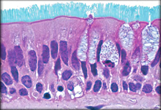
|
pseudostratified columnar (in the lungs) |
|
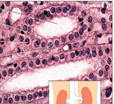
|
simple cuboidal (Kidneys, thyroid) |
|
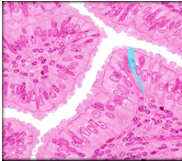
|
simple columnar (stomach, intestines) |
|

|
stratified squamous (oral cavity, vagina, anal cavity) |
|

|
stratified cuboidal (salivary glands, sweat glands) |
|
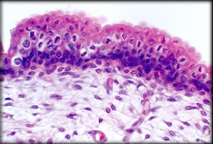
|
transitional (urinary bladder, ureters) |
|

|
stratified columnar (male urethera, ducts of exocrine glands) |
|
|
Glandular Epithelium: |
Composedof cells that produce and secrete substances into ducts or body fluids |
|
|
Endocrine glands |
secreteinto tissue fluid or blood |
|
|
exocrine glands |
secreteinto ducts that open onto surface |
|
|
Unicellular |
Composedof one cell, such as a goblet cell (secretes mucus) |
|
|
multicellular |
•Composed of manycells • Sweat glands,salivary glands, etc. • Simple or compound |
|
|
merocrine glands |
Secrete fluid products by exocytosis; salivary & sweatglands, pancreas |
|
|
Apocrine Glands: |
Lose small part of cell during secretion; mammary &ceruminous glands |
|
|
Holocrine Glands: |
Releaseentire cells filled with product; sebaceous glands |
|
|
fibroblast |
most common fixed cell
|
|
|
macrophages |
defend against infection |
|
|
mast cells |
•Large, fixed cells •Release heparin toprevent blood clotting•Release histamine,which causes inflammatory response |
|
|
collagen fibers |
•Thick threads ofcollagen, the body’s main structural protein •Great tensilestrength and flexible, slightly elastic •Found in ligamentsand tendons |
|
|
Elastic Fibers |
•Composed of elastinprotein; branching •Can stretch andreturn to original shape •Not as strong ascollagen fibers •Found in vocal cords,respiratory air passages |
|
|
Reticular Fibers |
•Thin, branchingfibers of collagen•Form delicate,supporting networks•Found in spleen,liver |
|
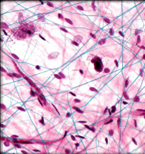
|
areolar |
|
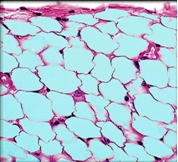
|
adipose |
|
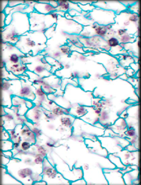
|
reticular |
|
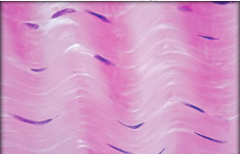
|
dense regular |
|
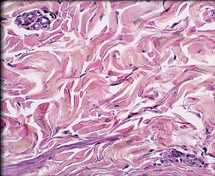
|
dense irregular |
|
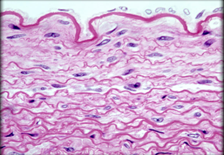
|
elastic |
|
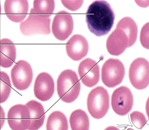
|
blood |
|
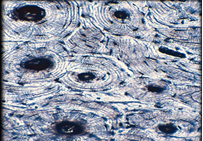
|
bone |
|
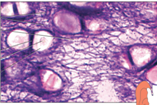
|
elastic cartilage |
|

|
fibrocartilage |
|

|
hyaline cartilage |
|
|
epithelial membranes |
composed of epithelial and connective tissue; cover body surfaces and line cavities
|
|
|
serous membranes |
line body cavities that do not open to outside of the body |
|
|
mucous membranes |
line cavities and tubes that open to the outside of body |
|
|
cutaneous membrane |
covers body surface (skin) |
|
|
synovial membranes |
composed entirely of connective tissue (lines joint cavities)
|
|
|
smooth muscle tissue |
spindle-shaped walls of organs and blood vessels (involuntary) |
|
|
cardiac muscle tissue |
only in wall of heart intercalated discs |
|
|
nervous tissue |
found in brain, spinal cord, peripheral nerves; main cells are neurons |
|
|
neuroglia |
support and nourish neurons |
|
|
organ |
two or more types of tissues grouped together and performing specialized functions |
|
|
integumentary system |
the skin, hair, nails, glands, sensory receptors |
|
|
epidermis |
outer layer of skin basement membrane between epidermis and dermis |
|
|
dermis |
inner layer of skin; contains collagenous and elastic fibers |
|
|
subcutaneous layer |
beneath dermis; insulating layer; contains blood vessels |
|
|
keratinocytes |
produce the protein keratin which helps protect the skin and underlying tissue from heat, microbes, etc. |
|
|
keratin |
tough, fibrous, waterproof protein made and stored in the cells |
|
|
keratinization |
process of hardening dehydration, and keratin accumulation that occurs in the epidermal cells as they migrate outward |
|
|
melanocytes |
produce the dark pigment melanin; provides skin color. |
|
|
Stratum basale |
deepest single layer of epidermis |
|
|
Stratum spinosum |
•providesstrength and flexibility to the skin |
|
|
Stratum granulosum |
•transition between the deeper, metabolically activestrata and the dead cells of the more superficial strata |
|
|
Stratum lucidum: |
•presentonly in the fingers tips, palms of the hands, and soles of the feet. |
|
|
Stratum corneum: |
•25to 30 layers of flat dead cells filled with keratin and surrounded by lipids–continuously shed |
|
|
three things that effect skin color |
hereditary factors environmental factors physiological factors |

